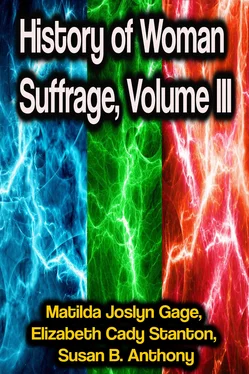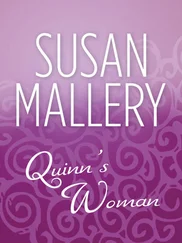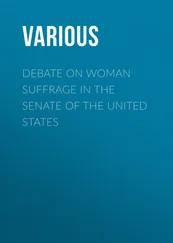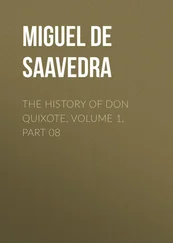Our Senate committee, through its chairman, Hon. Elbridge G. Lapham, very soon reported in favor of the submission of a sixteenth amendment. We had had a favorable minority report in the House in 1871 and in the Senate in 1879—but this was the first favorable majority report we had ever had in either house:
In the Senate, Monday, June 5, 1882.
Mr. Lapham: I am instructed by the Select Committee on Woman Suffrage, to whom was referred the joint resolution (S. R. No. 60) proposing an amendment to the Constitution of the United States, to report it with a favorable recommendation, without amendment, for the consideration of the Senate. This is a majority report, and the minority desire the opportunity to present their report also, and have printed the reasons which they give for dissenting. As this is a question of more than ordinary importance, I should like to have 1,000 extra copies of the report printed for the use of the committee.
Mr. George: I present the views of the minority of the committee, consisting of the senator from Tennessee [Mr. Jackson], the senator from Nevada [Mr. Fair], and myself.
The President pro tempore : It is moved that 1,000 extra copies of the report be printed for the use of the Senate.
Mr. Anthony: The motion should go by the statute to the Committee on Printing.
Mr. Lapham: I will present it in the form of a resolution for reference to the Committee on Printing.
The resolution was referred to the Committee on Printing, as follows:
Resolved , That 1,000 additional copies of the report and views of the minority on Senate Joint Resolution No. 60 be printed for the use of the Select Committee on Woman Suffrage.
In the Senate of the United States, June 5, 1882, Mr. Lapham, from the Committee on Woman Suffrage, submitted the following report:
The Select Committee on Woman Suffrage, to whom was referred Senate Resolution No. 60, proposing an amendment to the Constitution of the United States to secure the right of suffrage to all citizens without regard to sex, having considered the same, respectfully report:
The gravity and importance of the proposed amendment must be obvious to all who have given the subject the consideration it demands.
A very brief history of the origin of this movement in the United States and of the progress made in the cause of female suffrage will not be out of place at this time. A World's Anti-slavery Convention was held in London on June 12, 1840, to which delegates from all the organized societies were invited. Several of the American societies sent women as delegates. Their credentials were presented, and an able and exhaustive discussion was had by many of the leading men of America and Great Britain upon the question of their being admitted to seats in the convention. They were allowed no part in the discussion. They were denied seats as delegates, and, by reason of that denial, it was determined to hold conventions after their return to the United States, for the purpose of asserting and advocating their rights as citizens, and especially the right of suffrage. Prior to this, and as early as the year 1836, a proposal had been made in the legislature of the State of New York to confer upon married women their separate rights of property. The subject was under consideration and agitation during the eventful period which preceded the constitutional convention of New York in the year 1846, and the radical changes made in the fundamental law in that year. In 1848 the first act "For the More Effectual Protection of the Property of Married Women" was passed by the legislature of New York and became a law. It passed by a vote of 93 to 9 in the Assembly and 23 to 1 in the Senate. It was subsequently amended so as to authorize women to engage in business on their own account and to receive their own earnings. This legislation was the outgrowth of a bill prepared several years before under the direction of the Hon. John Savage, chief-justice of the Supreme Court, and of the Hon. John C. Spencer, one of the ablest lawyers in the State, one of the revisers of the statutes of New York, and afterward a cabinet officer. Laws granting separate rights of property and the right to transact business, similar to those adopted in New York, have been enacted in many, if not in most of the States, and may now be regarded as the settled policy of American legislation on the subject.
After the enactment of the first law in New York, as before stated, and in the month of July, 1848, the first convention demanding suffrage for women was held at Seneca Falls in said State. The same persons who had been excluded from the World's Convention in London were prominent and instrumental in calling the meeting and in framing the declaration of sentiments adopted by it, which, after reciting the unjust limitations and wrongs to which women are subjected, closed in these words:
Now, in view of this entire disfranchisement of one-half of the people of this country and their social and religious degradation; in view of the unjust laws above mentioned, and because women do feel themselves aggrieved, oppressed and fraudulently deprived of their most sacred rights, we insist that they have immediate admission to all the rights and privileges which belong to them as citizens of the United States. In entering upon the great work before us we anticipate no small amount of misconception, misrepresentation and ridicule; but we shall use every instrumentality within our power to effect our object. We shall employ agents, circulate tracts, petition the State and national legislatures, and endeavor to enlist the pulpit and the press in our behalf. We hope this convention will be followed by a series of conventions embracing every part of the country.
The meeting also adopted a series of resolutions, one of which was in the following words:
Resolved , That it is the duty of the women of this country to secure to themselves their sacred right to the elective franchise.
This declaration was signed by seventy of the women of Western New York, among whom was one or more of those who addressed your committee on the subject of the pending amendment, and there were present, participating in and approving of the movement, a large number of prominent men, among whom were Elisha Foote, a lawyer of distinction, and since that time Commissioner of Patents, and the Hon. Jacob Chamberlain, who afterwards represented his district in the other House. From the movement thus inaugurated, conventions have been held from that time to the present in the principal villages, cities and capitals of the various States, as well as the capital of the nation.
The First National Convention upon the subject was held at Worcester, Mass., in October, 1850, and had the support and encouragement of many leading men of the republic, among whom we name the following: Gerrit Smith, Joshua R. Giddings, Ralph Waldo Emerson, John G. Whittier, A. Bronson Alcott, Samuel J. May, Theodore Parker, William Lloyd Garrison, Wendell Phillips, Elizur Wright, William J. Elder, Stephen S. Foster, Horace Greeley, Oliver Johnson, Henry Ward Beecher, Horace Mann. The Fourth National Convention was held at the city of Cleveland, Ohio, October, 1853. The Rev. Asa Mahan, president of Oberlin College, and Hon. Joshua R. Giddings were there. Horace Greeley and William Henry Channing addressed letters to the convention. The letter of Mr. Channing stated the proposition to be that—
The right of suffrage be granted to the people, universally, without distinction of sex; and that the age for attaining legal and political majority be made the same for women as for men.
In 1857, Hon. Salmon P. Chase, chief-justice of the Supreme Court of the United States, then governor of Ohio, recommended to the legislature a constitutional amendment on the subject, and a select committee of the Senate made an elaborate report, concluding with a resolution in the following words:
Читать дальше












